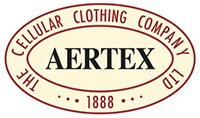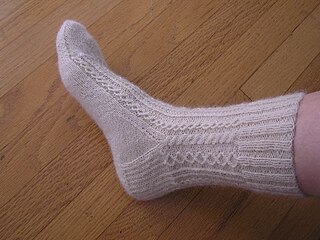
An eponym is a person, a place, or a thing after whom or which someone or something is, or is believed to be, named. The adjectives which are derived from the word eponym include eponymous and eponymic.

A parka and anorak is a type of coat with a hood, often lined with fur or faux fur. These two kinds of garments are staple of Inuit clothing, traditionally made from caribou or seal skin, for hunting and kayaking in the frigid Arctic. Some Inuit anoraks require regular coating with fish oil to retain their water resistance. Parkas are typically longer, often extending to the thighs or knees. Anoraks are usually shorter than parkas, often hip-length, and are traditionally a pull-over jacket.

A sweater or pullover, also called a jersey or jumper, is a piece of clothing, typically with long sleeves, made of knitted or crocheted material that covers the upper part of the body. When sleeveless, the garment is often called a slipover, tank top, or sweater vest.
This is a list of British words not widely used in the United States. In Commonwealth of Nations, Malaysia, Singapore, Hong Kong, Ireland, Canada, New Zealand, India, South Africa, and Australia, some of the British terms listed are used, although another usage is often preferred.

A shirt is a cloth garment for the upper body.

A jacket is a garment for the upper body, usually extending below the hips. A jacket typically has sleeves and fastens in the front or slightly on the side. A jacket is generally lighter, tighter-fitting, and less insulating than a coat, which is outerwear. Some jackets are fashionable, while others serve as protective clothing. Jackets without sleeves are vests.

Leggings are several types of leg attire that have varied through the years. Modern usage from the 1960s onwards has come to refer to elastic close-fitting high-rise garments worn over the legs typically by women, such as leg warmers or tights. Usage from the 18th century refers to men's wear usually made of cloth or leather that is wrapped around the leg down to the ankle. In the 19th century, leggings usually referred to infants' leg clothing that were matched with a jacket, as well as leg-wrappings made of leather or wool and worn by soldiers and trappers. Leggings prominently returned to women's fashion in the 1960s, drawing from the form-fitting clothing of dancers. With the widespread adoption of the synthetic fibre Lycra and the rise in popularity of aerobics, leggings came to further prominence in the 1970s and 1980s, and eventually made their way into streetwear. Leggings are a part of the late 2010s into the 2020s athleisure fashion trend of wearing activewear outside sporting activities and in casual settings.

A hoodie is a type of sweatshirt with a hood that partially or fully covers the wearer's head or face. Hoodies with zippers usually include two pockets on the lower front, one on either side of the zipper, while "pullover" hoodies often include a single large muff or pocket in the same location. Both styles (usually) include a drawstring to adjust the hood opening. When worn up, the hood covers most of the head and neck and sometimes the face. Hoodies may be worn for aesthetic purposes, or protection against the environment.

A dress shirt, button shirt, button-front, button-front shirt, or button-up shirt is a garment with a collar and a full-length opening at the front, which is fastened using buttons or shirt studs. A button-down or button-down shirt is a dress shirt with a button-down collar – a collar having the ends fastened to the shirt with buttons.

A sleeveless shirt is a shirt that is manufactured without sleeves or with sleeves that have been cut off. Depending on the style, they can be worn as undershirts, by athletes in sports such as track and field and triathlon, or as casual wear by both men and women.

Champion is a brand of clothing, specializing in sportswear owned and marketed by American apparel company Hanesbrands, which was spun off by the Sara Lee Corporation in 2006. The company was originally based in Rochester, New York, prior to its acquisition by Sara Lee in 1989. Champion is Hanes' second-largest brand.

A Baja jacket is a type of Mexican jacket with a single large pocket on the front, and vents on the side. They are more commonly made out of a coarse woolen fabric known as "jerga". They are often decorated with patterns consisting of horizontal stripes on the sleeves and hood, and vertical stripes down the rest of the jacket. The drawstrings are often flatter and more rectangular than most jacket drawstrings, and always made of the same material as the rest of the jacket.

Aertex was a British clothing company based in Manchester, established in 1888, and also the name of the fabric manufactured by the company. It owned the trademark for Aertex fabric, a lightweight and loosely woven cotton material that is used to make shirts and underwear.

A sock is a piece of clothing worn on the feet and often covering the ankle or some part of the calf. Some types of shoes or boots are typically worn over socks. In ancient times, socks were made from leather or matted animal hair. In the late 16th century, machine-knit socks were first produced. Until the 1800s, both hand-made and machine-knit socks were manufactured, with the latter technique becoming more common in the 19th century, and continuing until the modern day.

Russell Athletic is an American clothing manufacturer based in Bowling Green, Kentucky. Currently a subsidiary of global company Fruit of the Loom, Russell Athletic was the main brand of Russell Brands, LLC. until its acquisition in 2006.

American Giant is a San Francisco–based manufacturer of sportswear and casual clothing that sells directly to customers through its website. Its goods are all produced in the United States.















